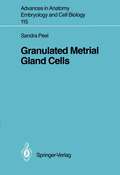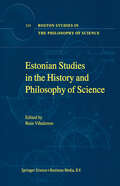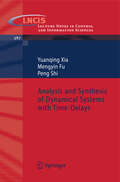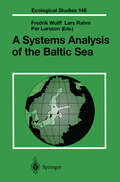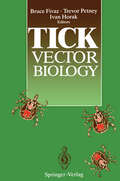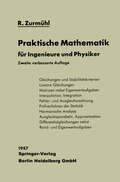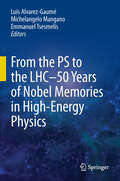- Table View
- List View
Optical Imaging and Microscopy: Techniques and Advanced Systems (Springer Series in Optical Sciences #87)
by Peter Török Fu-Jen KaoThis text on contemporary optical systems is intended for optical researchers and engineers, graduate students and optical microscopists in the biological and biomedical sciences. In three sections, the book discusses high-aperture optical systems, nonlinear optical techniques, and various techniques that are finding new applications. The new second edition has been thoroughly revised and expanded to account for new advances in fluorescence imaging and diffractive optical lenses.
Imaging Pelvic Floor Disorders (Medical Radiology)
by Steve Halligan Frederik M. Kelvin Jaap StokerThis book represents a landmark in the development of an imaging subspecialty that crosses the clinical boundaries of urogynaecology and coloproctology. It is the first text to consider the imaging of all pelvic floor disorders, addressing in depth both urinary and faecal incontinence and the various forms of prolapse. The book begins with a magnetic resonance-based review of the anatomy of the pelvic floor and an overview of how it functions; detailed chapters on investigation and treatment then follow, from both a clinical and a radiological perspective.
Granulated Metrial Gland Cells (Advances in Anatomy, Embryology and Cell Biology #115)
by Sandra Peel1. 1 Historical Aspects and Terminology Granulated metrial gland (GMG) cells are readily identified by their cytoplasmic granules and were observed a number of years before the term "metrial gland" was introduced. A series of papers by Duval in 1891 provided a comprehensive description and a critical review of earlier studies of the placenta of rodents, but it was not until 1902 that the first convincing illustrations of GMG cells appeared in the literature (Jenkinson 1902). Jenkinson described "maternal glycogen cells" in the pregnant mouse uterus and noted that they contained cytoplasmic granules which stained with a variety of dyes. From his detailed description of the appearance and distribution of these maternal glycogen cells it is clear that he had observed what are now called granulated metrial gland cells. In 1911 Ancel and Bouin used the phrase une glande myometriale endocrine to describe a structure appearing between the muscle layers of the uterus at the insertion site of the placenta in rabbits. They described one of the cell types present in the glande myometriale as having the characteristics of glandular cells and noted their content of safraninophilic cytoplasmic granules. A glande myometriale endo crine was also described in the pregnant rat uterus by Weill (1919). He reported that the cellules granuleuses contained acidophilic inclusions and despite the absence of any illustrations in his paper it is apparent that he also had observed GMG cells.
Microbial Life History: The Fundamental Forces of Biological Design
by Steven A. FrankA powerful framework for understanding how natural selection shapes adaptation and biological designDesign and diversity are the two great challenges in the study of life. Microbial Life History draws on the latest advances in microbiology to describe the fundamental forces of biological design and apply these evolutionary processes to a broad diversity of traits in microbial metabolism and biochemistry.Emphasizing how to formulate and test hypotheses of adaptation, Steven Frank provides a new foundation for exploring the evolutionary forces of design. He discusses the economic principles of marginal valuations, trade-offs, and payoffs in risky and random environments; the social aspects of conflict and cooperation; the demographic aspects of age and spatial heterogeneity; and the engineering control theory principles by which systems adjust to environments. Frank then applies these evolutionary principles to the biochemistry of microbial metabolism, providing the first comprehensive link between the forces that shape biological design and cellular energetics.Tracing how natural selection sculpts metabolism, Microbial Life History provides new perspectives on the life histories of organisms, from growth rate and survival to dispersal and defense against attack. Along the way, this incisive book addresses the conceptual and philosophical challenges confronting evolutionary biologists and other practitioners who study biological design and seek to apply its lessons.
Microbial Life History: The Fundamental Forces of Biological Design
by Steven A. FrankA powerful framework for understanding how natural selection shapes adaptation and biological designDesign and diversity are the two great challenges in the study of life. Microbial Life History draws on the latest advances in microbiology to describe the fundamental forces of biological design and apply these evolutionary processes to a broad diversity of traits in microbial metabolism and biochemistry.Emphasizing how to formulate and test hypotheses of adaptation, Steven Frank provides a new foundation for exploring the evolutionary forces of design. He discusses the economic principles of marginal valuations, trade-offs, and payoffs in risky and random environments; the social aspects of conflict and cooperation; the demographic aspects of age and spatial heterogeneity; and the engineering control theory principles by which systems adjust to environments. Frank then applies these evolutionary principles to the biochemistry of microbial metabolism, providing the first comprehensive link between the forces that shape biological design and cellular energetics.Tracing how natural selection sculpts metabolism, Microbial Life History provides new perspectives on the life histories of organisms, from growth rate and survival to dispersal and defense against attack. Along the way, this incisive book addresses the conceptual and philosophical challenges confronting evolutionary biologists and other practitioners who study biological design and seek to apply its lessons.
Estonian Studies in the History and Philosophy of Science (Boston Studies in the Philosophy and History of Science #219)
by Rein VihalemmThe development of geography also forms an interesting chapter in the history of the University ofTartu and in that of Estonian science in general. On the one hand, geography is a natural science in the broader sense ofthe word, on the other hand it is a study of human activity. This status of geography makes it particularly sensitive to the cultural and political circumstances under which scholarship and science have developed in Estonia. The article by Professor of Human Geography Ott Kurs (born 1939) and historian of science (PhD in geography) Erki Tamrniksaar (born 1969) "In Political Draughts Between Science and the Humanities: Geography at the University ofTartu Between the th th 17 -20 Centuries" is devoted to this topic. Among other things, the article states that regular instruction in geography started at the University of Tartu in 1826, when the second chair of geography in Europe was established here. Although the present book does not contain any studies on philosophy at th Tartu University in the 19 century, I would still like to mention two names. th In the early 19 century, I. Kant's philosophy was dominant at Tartu Uni versity. One of Kant's pupils, Gottlob Benjamin Jasche (1762-1839), who had worked under him as a Privatdozent in Konigsberg, served as a professor here from 1802-1839. In the history of philosophy he is primarily known as the publisher of Kant's Logic.
Galaxy Formation (Astronomy and Astrophysics Library)
by Malcolm S. LongairWritten by a well-known astrophysicist, who is also a superbly talented writer, this work deals with the matter and radiation content of the universe, the formation of galaxies, and provides a comprehensive introduction into relativistic astrophysics as needed for the clarification of cosmological ideas.
Analysis and Synthesis of Dynamical Systems with Time-Delays (Lecture Notes in Control and Information Sciences #387)
by Yuanqing Xia Mengyin Fu Peng ShiTime-delay occurs in many dynamical systems such as biological systems, chemical systems, metallurgical processing systems, nuclear reactor, long transmission lines in pneumatic, hydraulic systems and electrical networks. Especially, in recent years, time-delay which exists in networked control s- temshasbroughtmorecomplexproblemintoanewresearcharea.Frequently, itisasourceofthegenerationofoscillation,instabilityandpoorperformance. Considerable e?ort has been applied to di?erent aspects of linear time-delay systems during recent years. Because the introduction of the delay factor renders the system analysis more complicated, in addition to the di?culties caused by the perturbation or uncertainties, in the control of time-delay s- tems, the problems of robust stability and robust stabilization are of great importance. This book presents some basic theories of stability and stabilization of systems with time-delay, which are related to the main results in this book. More attention will be paid on synthesis of systems with time-delay. That is, sliding mode control of systems with time-delay; networked control systems with time-delay; networked data fusion with random delay.
Digital Astrophotography: The State of the Art (The Patrick Moore Practical Astronomy Series)
by David RatledgeProvides novice to accomplished amateur astronomers with a firm grounding in the basics and successful use of digital astrophotography. Provides examples of the best images, and gives readers hints and tips about how to get the best out of this extraordinary technology. Experts in CCD astronomy from North America and Europe have contributed to this book, illustrating their help and advice with many beautiful colour images – the book is in full color throughout. Techniques range from using simple webcams to highly technical aspects such as supernovae patrolling. Computer processing, stacking and image-enhancement are detailed, along with many hints and tips from the experts.
Imaging in Peripheral Arterial Disease: Clinical and Research Applications
by Christopher M. KramerThis book presents up-to-date information on clinical and research applications of imaging in peripheral arterial disease (PAD). It provides high-quality images useful not only in the diagnosis of PAD but also for use in clinical trials aimed at the development of novel therapies such as angiogenic agents and stem cells. The book begins with coverage of the applications of the four major imaging modalities in a clinical setting: ultrasound, computed tomography angiography (CTA), magnetic resonance angiography (MRA), and digital subtraction angiography (DSA). It also discusses the ankle brachial index (ABI) as a screening technique to establish the presence of PAD. Subsequent chapters focus on the advantages and limitations of various research applications of imaging in PAD including contrast ultrasound for measuring perfusion; MRI for assessing perfusion, energetics, plaque volume, and characteristics; and radionuclide imaging for perfusion and inflammation. Imaging in Peripheral Arterial Disease: Clinical and Research Applications is an essential resource for physicians, researchers, residents, and fellows in cardiology, radiology, imaging, nuclear medicine, diagnostic radiology, and vascular surgery.
A Systems Analysis of the Baltic Sea (Ecological Studies #148)
by F. V. Wulff L. A. Rahm P. LarssonDuring recent decades, large-scale effects of pollution on marine estuaries and even entire enclosed coastal seas have become apparent. One of the first regions where this was observed is the Baltic Sea, whereby the appearance of anoxic deep basins, extensive algal blooms and elimination of top predators like eagles and seals indicated effects of both increased nutrient inputs and toxic substances.This book describes the physical, biochemical and ecological processes that govern inputs, distribution and ecological effects of nutrients and toxic substances in the Baltic Sea. Extensive reviews are supplemented by budgets and dynamic simulation models.This book is highly interdisciplinary and uses a systems approach for analyzing and describing a marine ecosystem. It gives an overview of the Baltic Sea, but is useful for any marine scientist studying large marine ecosystems.
Einsteins Relativitätstheorie und die Geometrien der Ebene: Illustrationen zum Wechselspiel von Geometrie und Physik
by Dierck-Ekkehard LiebscherDer Faszination zweier scheinbar getrennter Gebiete - der Relativitätstheorie und der Geometrie - folgt dieses Buch: Thema ist die Geometrie in Raum und Zeit. Die Bewegung in Raum und Zeit bestimmt geometrische Konstruktionen, die jenseits der euklidischen Geometrie immer noch deren Klarheit und Zusammenhang bewahren. Dabei ist die Verblüffung zweiseitig: Relativitätstheorie wird Geometrie und Geometrie findet physikalische Entsprechung. Auf der einen Seite offenbaren sich in richtig konstruierten Abbildungen ohne komplizierte Formeln die erstaunlichen Ergebnisse der Relativitätstheorie und ihre Widerspruchsfreiheit. Auf der anderen Seite ergeben sich ganz ungewohnte und unerwartete, aber physikalisch bedeutsame einfache Beispiele für nichteuklidische Geometrien, in denen noch mit Gerade und Kegelschnitt konstruiert werden kann.
Tick Vector Biology: Medical and Veterinary Aspects
by Bruce Fivaz Trevor Petney Ivan HorakThe book provides a comprehensive account of ticks and tick-borne diseases occurring in tropical and subtropical areas. It begins with a complete up-to-date overview of the systematics of the Ixodida (Ixodidae, Argasidae and Nutalliellidae) and is followed by a review of the problem of ticks and tick-borne diseases of domestic animals world wide. This leads on to multi-disciplinary approaches to planning tick and tick-borne disease control and to contributions on calculating the economic impact of a tick species such as Amblyomma americanum on beef production systems. Heartwater fever (cowdriosis) and dermatophilosis are endemic in Africa and pose a threat to the North American mainland. The epidemiology of these two diseases is discussed in detail as is the role of frozen vaccines to control bovine babesiosis and anaplasmosis. The book also includes chapters on tick transmitted zoonoses such as Lyme borreliosis, tick typhus and ehrlichiosis. It concludes with a review of the acaricidal treatment of tick infestation.
Ronald Reagan and the Space Frontier (Palgrave Studies in the History of Science and Technology)
by John M. LogsdonWhen Ronald Reagan was elected in 1980, limits on NASA funding and the lack of direction under the Nixon and Carter administrations had left the U.S. space program at a crossroads. In contrast to his predecessors, Reagan saw outer space as humanity’s final frontier and as an opportunity for global leadership. His optimism and belief in American exceptionalism guided a decade of U.S. activities in space, including bringing the space shuttle into operation, dealing with the 1986 Challenger accident and its aftermath, committing to a permanently crewed space station, encouraging private sector space efforts, and fostering international space partnerships with both U.S. allies and with the Soviet Union. Drawing from a trove of declassified primary source materials and oral history interviews, John M. Logsdon provides the first comprehensive account of Reagan’s civilian and commercial space policies during his eight years in the White House. Even as a fiscal conservative who was hesitant to increase NASA’s budget, Reagan’s enthusiasm for the space program made him perhaps the most pro-space president in American history.
Infrared Holography for Optical Communications: Techniques, Materials and Devices (Topics in Applied Physics #86)
by Pierpaolo Boffi Davide Piccinin Maria C. UbaldiThe aim of this book is to exploit the advantages of holographic technology, in order to implement optical devices for infrared fibre communication applications. It covers methods ranging from two-lambda to gated recording techniques.
Funktionelle Ultrastruktur: Atlas der Biologie und Pathologie von Geweben
by Margit Pavelka Jürgen RothMit dem Blick auf die Feinstrukturen werden die Innenräume der Zellen und ihre Architekturen in der höheren Organisation der Gewebe lebendig. Die Autoren geben mit diesem Atlas der funktionellen Ultrastruktur Einblick in die komplexe zelluläre Innenwelt mit ihren vielgestaltigen Funktionsräumen, sowie in dynamische Funktionsabläufe, die für die Erfüllung der zellulären Aufgaben im Gewebe notwendig sind. Das besondere Anliegen besteht darin, dem Leser bewusst zu machen, dass es sich hier um diejenigen Strukturen handelt, in denen sich grundlegende zelluläre Lebensvorgänge und krankmachende Mechanismen abspielen. An Hand elektronenmikroskopischer Bilder, ergänzt durch Immunelektronenmikroskopie und ausführlicher Beschreibung werden in den Zellen die Beziehungen zwischen Strukturen und Funktionen aufgerollt, Details herausgearbeitet und die Organisation in den Zellverbänden der Gewebe präsentiert. Das Buch wendet sich an Medizin- und Naturwissenschaftsstudenten, Ärzte, Biologen, Zell- und Molekularbiologen.
Effect-Directed Analysis of Complex Environmental Contamination (The Handbook of Environmental Chemistry #15)
by Werner BrackToday more than 5 million chemicals are known and roughly 100,000 of them are frequently used, with both numbers rising. Many of these chemicals are ultimately released into the environment and may cause adverse effects to ecosystems and human health. Effect-directed analysis (EDA) is a promising tool for identifying predominant toxicants in complex, mostly environmental mixtures combining effect testing, fractionation and chemical analysis. In the present book leading experts in the field provide an overview of relevant approaches and tools used in EDA. This includes diagnostic biological tools, separation techniques and advanced analytical and computer tools for toxicant identification and structure elucidation. Examples of the successful application of EDA are discussed such as the identification of mutagens in airborne particles and sediments, of endocrine disruptors in aquatic ecosystems and of major toxicants in pulp and paper mill effluents. This book is a valuable, comprehensive and interdisciplinary source of information for environmental scientists and environmental agencies dealing with the analysis, monitoring and assessment of environmental contamination.
Modern Theory of Crystal Growth I (Crystals #9)
by A. A. Chernov H. Müller-KrumbhaarOur understanding of the basic processes of crystal growth has meanwhile reached the level of maturity at least in the phenomenological concepts. This concerns for example the growth of pure crystals from a low-density nutrient phase like vapor or dilute solution with various aspects of pattern formation like spiral and layer growth, facetting and roughening, and the stability of smooth macroscopic shapes, as well as basic mechanisms of impurity incorporation in melt growth of (in this sense) simple materials like silicon or organic model substances. In parallel the experimental techniques to quantitatively ana lyze the various growth mechanisms have also reached a high level of reproducibility and precision, giving reliable tests on theoretical predictions. These basic concepts and appli cations to experiments have been recently reviewed by one of us (A. A. C. ) in "Modern Crystallography III. Crystal Growth" (Springer Series on Solid State Sciences, 1983). It has to be emphasized, however, that for practical applications we are still unable to quantitatively calculate many important parameters like kinetic coefficients from first principles. For mixed systems such as complex oxides, solutions and systems with chemi cal reactions, our degree of understanding is even lower. As a few examples for present achievements we note that experiments with vapour and molecular beam condensation of alkali halides confirmed the qualitatively predicted mechanisms of screw dislocations and two-dimensional nucleation for layer-growth.
Praktische Mathematik: für Ingenieure und Physiker
by Rudolf ZurmühlDas Buch ist gedacht als eine Ergänzung und Fortführung der mathematischen Grundlagenvorlesung der Technischen Hochschule. Es möchte den jungen Ingenieurstudenten zu einer über diese Vorlesung hinausgehenden Beschäftigung mit jenem Zweig der Mathematik an regen, der für die zahlenmäßige Behandlung von Ingenieuraufgaben aller Art grundlegend ist: mit den numerischen V erfahren der praktischen Mathematik. In diese Methoden, ihre Theorie und ihre praktische Hand habung führt es ein, wobei gleicher Wert auf klare Entwicklung der theoretischen Grundgedanken wie auf Einzelheiten der Zahlen rechnung gelegt wird. Aber auch dem in der Praxis tätigen Ingenieur möchte das Buch eine Hilfe sein, wenn er bei der Durchführung seiner Aufgaben vorder Notwendigkeit steht, auf numerische V erfahren zurück zugreifen. Ein Buch, das sich an Ingenieure und Physiker wendet, muß in mancher Hinsicht anders abgefaßt sein als ein für Mathematiker be stimmtes. Es soll gewiß nicht weniger zuverlässig und einwandfrei sein. Aber während der Mathematiker in die Lage versetzt werden soll, selbst aktiv an der Entwicklung neuer Methoden mitzuarbeiten, sollen Physi ker und Ingenieur in erster Linie die praktische Handhabung der Metho den erlernen, um sie als Hilfsmittel für ihre eigentliche Berufsarbeit anzuwenden. Damit sie das sinnvoll und richtig können, müssen sie freilich die mathematischen Grundlagen eines Verfahrens voll verstan den haben. Mit einer bloßen Rezeptsammlung ist auch ihnen durchaus nicht gedient.
Röntgenologie des Felsenbeines und des Bitemporalen Schädelbildes: Mit Besonderer Berücksichtigung Ihrer Klinischen Bedeutung (Röntgenkunde in Einzeldarstellungen #1)
by H. W. StenversDieser Buchtitel ist Teil des Digitalisierungsprojekts Springer Book Archives mit Publikationen, die seit den Anfängen des Verlags von 1842 erschienen sind. Der Verlag stellt mit diesem Archiv Quellen für die historische wie auch die disziplingeschichtliche Forschung zur Verfügung, die jeweils im historischen Kontext betrachtet werden müssen. Dieser Titel erschien in der Zeit vor 1945 und wird daher in seiner zeittypischen politisch-ideologischen Ausrichtung vom Verlag nicht beworben.
From the PS to the LHC - 50 Years of Nobel Memories in High-Energy Physics
by Luis Alvarez-Gaumé, Michelangelo Mangano and Emmanuel TsesmelisThis collection of lectures and essays by eminent researchers in the field, many of them nobel laureates, is an outgrow of a special event held at CERN in late 2009, coinciding with the start of LHC operations. Careful transcriptions of the lectures have been worked out, subsequently validated and edited by the lecturers themselves. This unique insight into the history of the field includes also some perspectives on modern developments and will benefit everyone working in the field, as well as historians of science.
Convergence Clubs and Spatial Externalities: Models and Applications of Regional Convergence in Europe (Advances in Spatial Science)
by Stilianos AlexiadisDo dynamic externalities, in the form of technology creation, adoption and spatial agglomeration shape the pattern of regional growth in Europe? This study provides an alternative view on regional convergence. A model is developed which attributes club-convergence to existing differences with respect to the degree of technology adoption. In the first instance, empirical results suggest that the NUTS-2 regions of the EU-27 converge at a very slow rate. Further tests, however, indicate that convergence is restricted to a specific subset of regions. Such conclusions are tested further, using an alternative model of club-convergence, which incorporates the impact of spatial interaction, agglomeration externalities and technology. This shows that the convergence-club in Europe follows a certain geographical pattern and all members share similar characteristics regarding technology creation and adoption, and agglomeration externalities.
Models of Man: A Phenomenological Critique of Some Paradigms in the Human Sciences
by J.J. DagenaisThis essay is, first, a theoretical and historical study of some classical scientific ways of studying human being in the world. The more readily accessible and more commonly discussed "models" of being human were chosen for review here, but structuralism is included because I believe it will have ,the same impact in America as it has had in France, and I hope that American readers might be forewarned about what may be ideologically at stake before the technical, and fruitful, aspects of the movement become an academic fad in the United States. The subjects included are mainline experimental psychology from Wundt to Skinner, with its relatively shortlived functionalist and Watsonian-behaviorist formulations; holistic psychology from Brentano through Stumpf, Husserl, and Goldstein to Maslow, Rogers, and contemporary "third force" psychology; and the psychoanalytic model, for which the only paradigm is Freud himself. Preeminence is given to psychological paradigms, since their subject matter lies closest to the classical philosophical tradition from which "philosophical anthropology" emerged. (This book is, in the final analysis, a prolegomenon to an articulated philosophical anthropo logy. ) Sociological models are also considered: the "classical" tradition from Comte to the present, and Marxist anthropology from the manu scripts of 1844 to the present. The structuralist model, from Durkheim to Chomsky, is also considered, since it cuts across and gives new dimensions to all the foregoing models. The essay is, second, a phenomenological critique of these historico theoretical considerations.
Fluid Vortices (Fluid Mechanics and Its Applications #30)
by Sheldon GreenFluid Vortices is a comprehensive, up-to-date, research-level overview covering all salient flows in which fluid vortices play a significant role. The various chapters have been written by specialists from North America, Europe and Asia, making for unsurpassed depth and breadth of coverage. Topics addressed include fundamental vortex flows (mixing layer vortices, vortex rings, wake vortices, vortex stability, etc.), industrial and environmental vortex flows (aero-propulsion system vortices, vortex-structure interaction, atmospheric vortices, computational methods with vortices, etc.), and multiphase vortex flows (free-surface effects, vortex cavitation, and bubble and particle interactions with vortices). The book can also be recommended as an advanced graduate-level supplementary textbook. The first nine chapters of the book are suitable for a one-term course; chapters 10--19 form the basis for a second one-term course.
Johan Galtung: Pioneer of Peace Research (SpringerBriefs on Pioneers in Science and Practice)
by Johan Galtung Dietrich FischerThis is the first ever anthology of key articles by Johan Galtung, widely regarded as the founder of the academic discipline of peace studies. It covers such concepts as direct, structural and cultural violence; theories of conflict, development, civilization and peace; peaceful conflict transformation; peace education; mediation; reconciliation; a life-sustaining economy; macro-history; deep culture and deep structure; and social science methodology. Galtung has contributed original research, concepts and theories to more than 20 social science disciplines, including sociology, international relations and future studies, and has also applied his new insights in practice. The book is a valuable resource for researchers and practitioners, and can serve as a supplemental textbook for graduate and upper undergraduate courses in peace studies and related fields.


